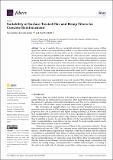| dc.contributor.author | da Costa Santos, Ana Caroline | |
| dc.contributor.author | Archbold, Paul | |
| dc.date.accessioned | 2023-03-21T12:33:31Z | |
| dc.date.available | 2023-03-21T12:33:31Z | |
| dc.date.copyright | 2022 | |
| dc.date.issued | 2022-11-17 | |
| dc.identifier.citation | da Costa Santos, A. C., Archbold, P. (2022). Suitability of surface-treated flax and hemp fibers for concrete reinforcement. Fibers. 10, 101. Reinforcement. Fibers 2022, 10, 101. doi.org/ 10.3390/fib10110101 | en_US |
| dc.identifier.uri | https://research.thea.ie/handle/20.500.12065/4431 | |
| dc.description.abstract | The use of vegetable fibres as a sustainable alternative to non-natural sources of fibres
applied for concrete reinforcement has been studied for over three decades. The main issues about
plant-based fibres pointed out by other authors are the variability in their properties and concerns
about potential high biodegradability in the alkaline pH of the concrete matrix. Aiming to minimise
the variability of flax and hemp fibres, this research compares a range of chemical surface treatments,
analysing their effects on the behaviour of the fibres and the effects of their addition to concrete.
Corroborating what has been found by other authors, the treatment using NaOH 10% for 24 h was
able to enhance the properties of hemp fibre-reinforced concrete and reduce the degradability in
alkaline solution. For flax fibres, a novel alternative stood out: treatment using 1% of stearic acid in
ethanol for 4 h. Treatment using this solution increased the tensile by 101%, causing a minor effect on
the elastic modulus. Concrete mixes reinforced with the treated flax fibres presented reduced thermal
conductivity and elastic modulus and increased residual tensile strength and fracture energy. | en_US |
| dc.language.iso | eng | en_US |
| dc.publisher | MDPI | en_US |
| dc.relation.ispartof | Fibers | en_US |
| dc.rights | Attribution-NonCommercial-NoDerivs 3.0 United States | * |
| dc.rights.uri | http://creativecommons.org/licenses/by-nc-nd/3.0/us/ | * |
| dc.subject | Production of vegetable fibre reinforced concete (FRC) | en_US |
| dc.subject | Extraction of flax and hemp fibres | en_US |
| dc.subject | Surface treatment of vegetable fibres | en_US |
| dc.subject | Degradability of plant fibres into the alkaline matrix | en_US |
| dc.subject | Mechanical properties of FRC | en_US |
| dc.subject | Fracture energy of natural fibre reinforced concrete | en_US |
| dc.title | Suitability of surface-treated flax and hemp fibers for concrete reinforcement | en_US |
| dc.type | info:eu-repo/semantics/article | en_US |
| dc.contributor.affiliation | Technological University of the Shannon: Midlands Midwest | en_US |
| dc.contributor.sponsor | This work was funded by the Government of Ireland Scholarship (Grant number P221-279) and the Technological University of the Shannon: Midlands President Doctoral Scholarship fund and HEA [Higher Education Authority] and D/FHERIS [The Department of Further and Higher Education, Research, Innovation and Science]. | en_US |
| dc.description.peerreview | yes | en_US |
| dc.identifier.doi | 10.3390/fib10110101 | en_US |
| dc.identifier.eissn | 2079-6439 | |
| dc.identifier.orcid | https://orcid.org/0000-0003-0618-6136 | en_US |
| dc.identifier.orcid | https://orcid.org/0000-0003-2464-7258 | en_US |
| dc.rights.accessrights | info:eu-repo/semantics/openAccess | en_US |
| dc.subject.department | Department of Civil Engineering and Trades: TUS Midlands | en_US |
| dc.type.version | info:eu-repo/semantics/publishedVersion | en_US |


